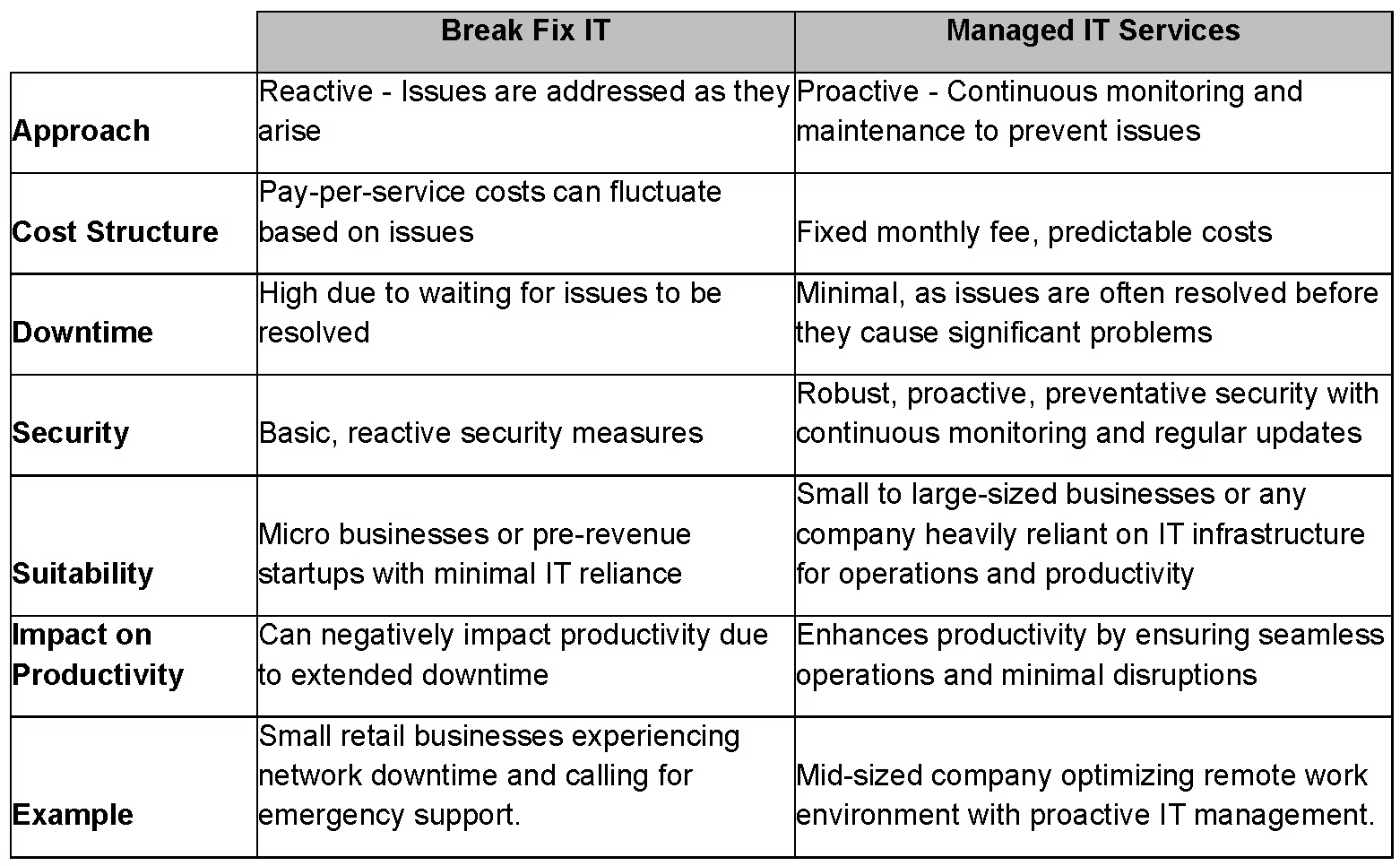
In today's technology-driven business environment, choosing the suitable IT support model ensures smooth operations and sustained growth. Two common approaches are Break Fix services and Managed Services. While both aim to address IT issues, they differ significantly in their approach, cost structure, and overall impact on business operations.
Break Fix IT
Break Fix IT operates on a reactive basis, addressing issues only after they occur rather than ensuring they don't break in the first place through regular maintenance and monitoring. Break-Fix waits for you to discover the problem and call for service, akin to hiring an emergency plumber; you call them when needed, and they address the immediate issue.
The primary advantage of Break Fix IT is that they are contract-free, meaning you only pay for the service when you need it. Contract-free can benefit micro businesses or pre-revenue startups with minimal reliance on technology, allowing for control over I.T. expenses without recurring expenditures.
However, the unpredictability of Break Fix services can be a significant drawback that leads to financial, operational, and reputational risks, making it less ideal for those seeking stability and reliability in their IT infrastructure. You can never predict when an issue will arise or how severe it will be. This reactive approach can lead to sudden, costly, unplanned disruptions that impact your business:
Costs can fluctuate based on the frequency and severity of IT issues, leading to potentially high expenses during frequent technical problems.[I]
Additionally, the reactive nature of this model can result in extended downtime, which can negatively impact productivity and profitability until the problem is resolved.[ii]
Real-World Example of Break Fix IT
Consider a small retail business that relies on a Break Fix IT provider. One day, their network goes down, preventing them from processing sales transactions.
They immediately call their IT Due to availability, The Break Fix provider can't send a technician for a day or two. Then, once on site, the technician will diagnose and address the issue. The technician discovered that the router had failed and needed to be replaced. Break Fix service providers typically have to order new equipment and don't have hot swappable spares on hand. After waiting for the new equipment and the installation, the business is back online, but the downtime resulted in lost sales and frustrated customers.[iii]
Statistics on Break Fix IT
The average cost of downtime is $5,600 per minute, according to a 2014 study by Gartner.[iv] However, the research firm quickly points out that this is just average. An Avaya report the same year found that averages ranged from $2,300 to $9,000 per minute depending on factors like company size and industry vertical. And since 2014, that figure has been rising. A more recent report (from Ponemon Institute in 2016) raises Gartner's average from $5,600 per minute to nearly $9,000 per minute.[v]
For small businesses, that number drops to the lower but still significant tune of $137 to $427 per minute. And where your company falls on this vast spectrum depends on many factors, including industry vertical, organization size, and business model.[vi]
Managed IT Services
Managed IT services, on the other hand, operate on a proactive basis. Instead of waiting for something to break, managed services aim to prevent issues from occurring in the first place. This model involves outsourcing the management and support of your IT infrastructure to a specialized provider who provides continuous monitoring, maintenance, security, and support for a fixed monthly fee.[vii] The proactive approach of Managed IT services ensures minimal downtime and disruption to business operations, as issues are proactively identified and resolved before they can cause significant problems.[viii]
One of the primary advantages of Managed IT services is predictability. The fixed monthly fee allows businesses to budget effectively, eliminating unexpected expenses. This model also provides robust security through continuous monitoring, regular security updates, and proactive threat management, protecting your business from cyber threats and data breaches. For small- to large-sized businesses or any company heavily reliant on its IT infrastructure, managed I.T. services can prevent costly downtime and enhance productivity.[ix]
Statistics on Managed IT Services
The global managed IT services market is expected to reach $319.5 billion by 2028, driven by increasing digitalization and the need for efficient IT management.[x] Additionally, 71% of organizations outsource their IT functions to managed service providers to access specialized skills, reduce costs, and improve overall IT performance.
Conclusion
Choosing between Break Fix IT services and Managed IT services depends on your business's specific needs and resources. While Break Fix may suit micro businesses with minimal IT reliance, Managed IT services offer a more comprehensive and proactive approach, ensuring higher reliability, security, and overall efficiency. By understanding the critical differences between these two models, businesses can make informed decisions that align with their operational goals and budget constraints.

About the Author
Named one of Inc Magazine’s 5000 fastest-growing private companies in America, Alcott Enterprises is an award-winning national information technology consulting and cybersecurity company delivering agile IT strategies and next-generation IT managed services.